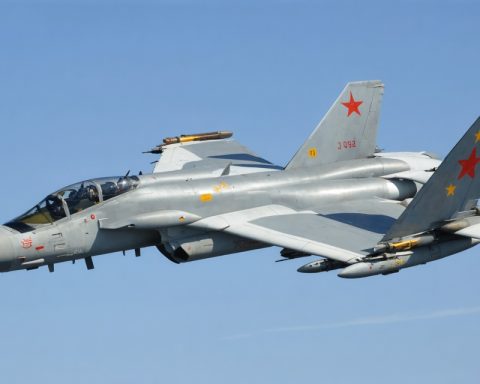- Ravyn Technology Corp., founded in 2019, is revolutionizing missile technology with its Mobile Mass Missile System, aiming to reduce costs by tenfold.
- Ravyn’s missiles are designed to travel 1,600 kilometers in space at speeds exceeding Mach 10, showcasing a futuristic approach to reentry and missile performance.
- The venture seeks to inject competition into the defense sector, traditionally dominated by established entities.
- The defense industry is experiencing a surge in interest and investment in hypersonic weapons and solid rocket motors, with companies like Castelion and X-Bow Systems securing substantial funding.
- Ravyn employs vertical integration and practical design to lower production costs, receiving praise from defense insiders like Alfred Abramson III for reinvigorating the Defense Industrial Base.
- Saad Mirza, the founder, exemplifies youthful innovation, transitioning from student rocket launches to leading cutting-edge missile development.
A new era of missile development takes flight from Washington’s emerging tech powerhouse, Ravyn Technology Corp. With an audacious ambition to slash missile costs by a staggering tenfold, Ravyn’s Mobile Mass Missile System promises to disrupt the defense sector with an innovative approach that combines simplicity, efficiency, and affordability.
Founded in 2019, Ravyn’s missiles are futuristic marvels—capable of soaring 1,600 kilometers in space at breathtaking speeds north of Mach 10. Their reentry is no less dramatic, gliding gracefully over vast distances, challenging the status quo of missile technology. Saad Mirza, the visionary behind Ravyn, seeks to inject competition and dynamism into a market that has long been the domain of entrenched players.
The buzz around hypersonic weapons and solid rocket motors is electrifying the defense landscape. Rivals and allies alike sense the market’s pulse quickening—California’s Castelion recently captured $100 million for its hypersonic missile venture, while X-Bow Systems secured $70 million to bolster its rocket motor production. Even the seasoned Anduril Industries is pivoting into solid rocket motors, emphasizing the untapped potential and demand.
Ravyn’s strength lies not just in groundbreaking ideas but in the meticulous craft of vertical integration—driving down costs through practical design and mass production. The firm’s strategy echoes through the thoughts of Alfred Abramson III, a retired U.S. Army brigadier general, who applauds the startup for breathing new life into the Defense Industrial Base.
Beneath the soaring ambitions is a tale of youthful ingenuity. Saad Mirza, once a university student launching rockets, now orchestrates a symphony of design and engineering prowess. As Ravyn conducts tests and fine-tunes its creations in California’s Mojave Desert, a clear message emerges: small innovators can indeed revolutionize timeworn industries.
How Ravyn Technology Could Revolutionize the Missile Defense Industry
How-To Steps & Life Hacks: Embracing Vertical Integration
Ravyn Technology Corp’s innovative model for reducing missile costs pivots heavily on vertical integration. Here’s how companies can implement similar strategies:
1. Assess Your Supply Chain: Identify key components and processes you rely on and estimate potential cost savings from internalizing them.
2. Invest in Technology: Embrace advanced manufacturing technologies, like 3D printing and automation, to streamline design and production processes.
3. Build Expertise In-House: Develop a workforce skilled in areas currently filled by third-party suppliers to enhance agility and quality control.
4. Collaborate with Innovators: Partner with technology innovators and startups to push boundaries and adapt quickly to new advancements.
Real-World Use Cases: Practical Applications of Hypersonic Missiles
Ravyn’s hypersonic missile technology has a range of potential applications:
– Military Defense: Rapid response to threats with greater precision and speed than traditional missiles.
– Space Exploration: Components of hypersonic technology could be adapted for efficient space transportation.
– Commercial Aerospace: Spin-off technologies may lead to faster transcontinental travel.
Market Forecasts & Industry Trends
The global hypersonic missile market is anticipated to grow rapidly, driven by increased defense budgets and technological advancements. Fortune Business Insights projects that the hypersonic technology market will reach $13.97 billion by 2025.
Reviews & Comparisons
Ravyn Technology vs. Castelion vs. X-Bow Systems:
– Ravyn Technology: Known for cost-effectiveness and innovation through vertical integration in hypersonic missile development.
– Castelion: Focuses heavily on hypersonic speed and precision technology, securing substantial investment and backing.
– X-Bow Systems: Specializes in solid rocket motors, emphasizing production efficiency and reliability.
Controversies & Limitations
While Ravyn Technology’s ambitious cost-reduction claim is promising, potential challenges include:
– Technical Hurdles: Achieving stable hypersonic speeds with consistent performance.
– Regulatory Scrutiny: Navigating international arms regulations and export control restrictions.
Features, Specs & Pricing
– Speed: North of Mach 10.
– Range: Capable of covering 1,600 kilometers in space.
– Design: Focuses on simplicity and efficiency for reduced production costs.
– Pricing: Aims to reduce missile costs by tenfold, though exact figures remain undisclosed.
Security & Sustainability
Ravyn Technology is expected to align with stringent security protocols due to the sensitive nature of missile technology. There is also potential for adopting sustainable practices by minimizing waste through efficient manufacturing.
Insights & Predictions
Industry experts foresee startups like Ravyn transforming the defense landscape by making hypersonic technology more accessible and cost-efficient, potentially leading to broader adoption beyond military uses.
Tutorials & Compatibility
To understand hypersonic technology better, consider enrolling in courses on aerospace engineering or seeking tutorials on missile propulsion systems and aerodynamics.
Pros & Cons Overview
Pros:
– Significant cost reduction potential.
– Innovative use of vertical integration.
– Capable of high-speed, long-range travel.
Cons:
– Technical and regulatory challenges.
– Market competition from established players and emerging innovators.
Recommendations and Quick Tips
– For Innovators: Smaller companies should prioritize vertical integration and partnerships to remain competitive.
– For Investors: Keep an eye on startups disrupting traditional defense models; they’re likely to offer strategic opportunities.
– For Regulators: Prepare for new entrants in the defense sector with frameworks that encourage innovation while maintaining security standards.
Explore more about developments in aerospace and defense technology at Defense News and American Institute of Aeronautics and Astronautics for the latest in aerospace advancements.











